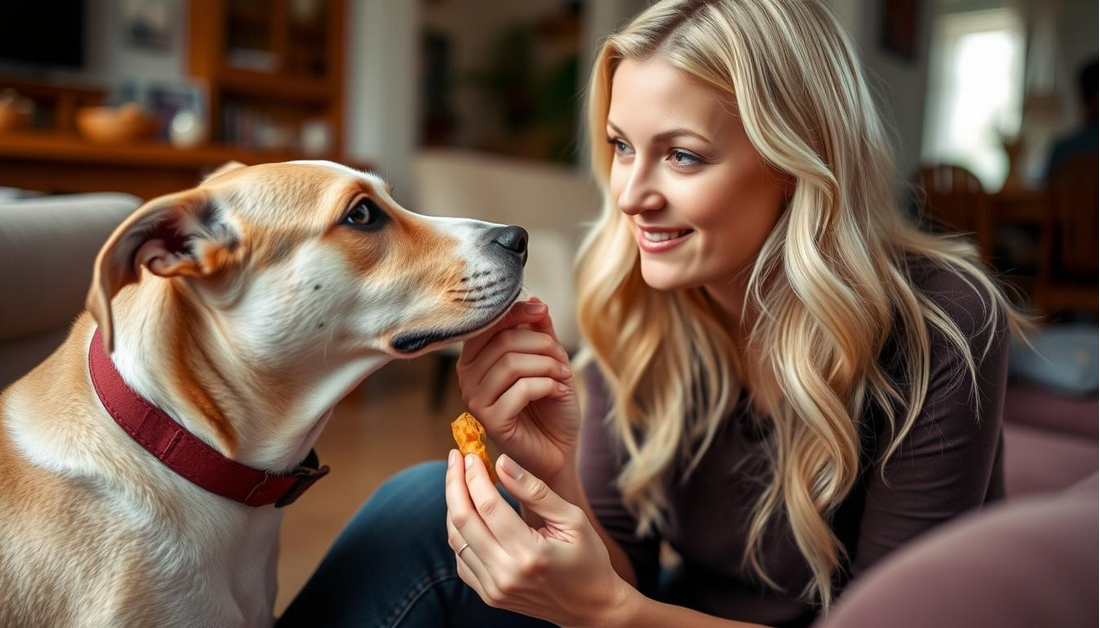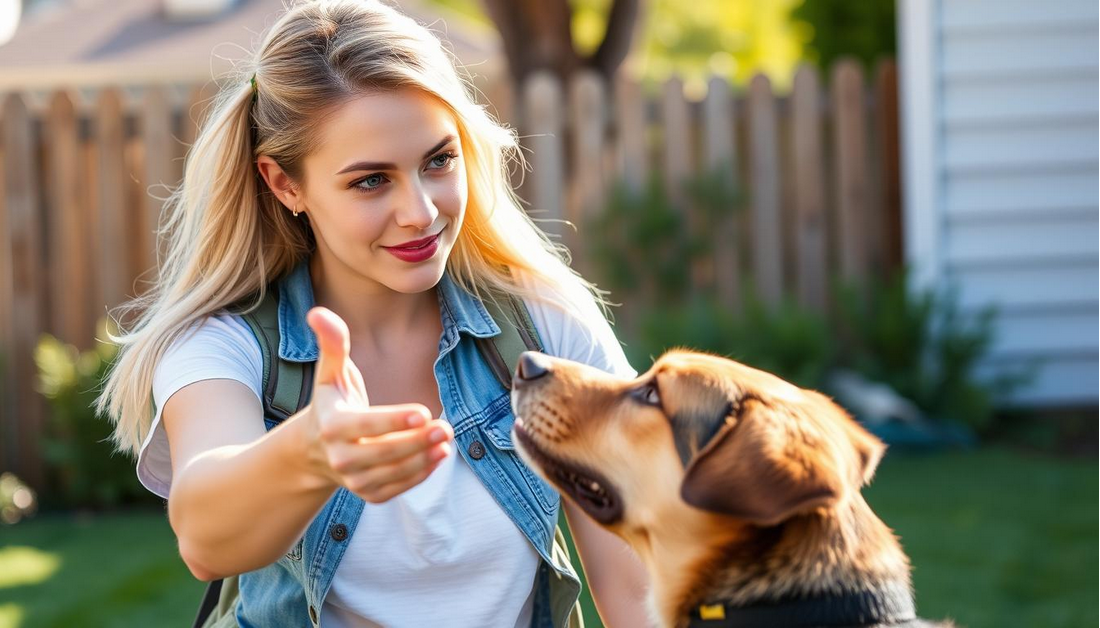India customers to view on amazon.in
How to Train Pets Using Hand Signals?
Training your pet using hand signals is an effective way to communicate with them, especially in noisy environments or for pets that are deaf or have hearing impairments.
- The Benefits of Training Pets with Hand Signals
- Enhanced Communication Between Pet and Owner
- Practical Applications in Noisy Environments
- Benefits for Deaf or Hearing-Impaired Pets
- Understanding How Pets Interpret Visual Cues
- The Science Behind Visual Learning in Animals
- How Different Pets Process Visual Information
- Why Some Pets Learn Visual Commands Faster Than Others
- Essential Equipment and Preparation for Hand Signal Training
- Creating the Right Training Environment
- Treats and Rewards for Positive Reinforcement
- Training Schedules and Consistency
- Basic Hand Signals for Common Commands
- How to Train Pets Using Hand Signals: Step-by-Step Guide
- Introducing Your Pet to Hand Signals
- Pairing Verbal Commands with Hand Signals
- Transitioning to Hand Signals Only
- Reinforcement Techniques
- Species-Specific Hand Signal Training Techniques
- Hand Signal Training for Dogs
- Hand Signal Training for Cats
- Hand Signal Training for Birds
- Hand Signal Training for Small Mammals
- Advanced Hand Signals for Complex Behaviors
- Training Directional Commands
- Teaching Object Identification
- Multi-Step Command Sequences
- Distance Training with Hand Signals
- Troubleshooting Common Hand Signal Training Issues
- When Your Pet Ignores Hand Signals
- Confusion Between Similar Signals
- Regression in Training Progress
- Environmental Distractions
- Special Considerations for Training Deaf Pets
- Adapting Training Methods for Hearing-Impaired Pets
- Getting Your Deaf Pet’s Attention
- Safety Considerations for Deaf Pets
- Incorporating Hand Signals into Daily Routines
- Using Hand Signals During Walks
- Hand Signals for Mealtime Behavior
- Social Situations and Hand Signal Control
- Hand Signals for Emergency Situations
- Consistency and Patience: Keys to Successful Signal Training
- Setting Realistic Training Goals
- Maintaining Signal Consistency Among Family Members
- Dealing with Training Plateaus
- Celebrating Small Victories
- Conclusion
- FAQ
- What are the benefits of training pets with hand signals?
- How do I start training my pet using hand signals?
- Can hand signal training be used for different species of pets?
- How do I troubleshoot common hand signal training issues?
- Are there any special considerations for training deaf pets using hand signals?
- How can I incorporate hand signals into my daily routines with my pet?
- What are some tips for maintaining consistency in hand signal training?
- Can I use hand signals to train my pet to perform complex behaviors?
- How long does it take to train a pet using hand signals?

This method allows you to develop a strong bond with your pet and improve their behavior with patience and consistency. Effective pet training techniques involve using clear and concise hand signals that your pet can easily understand.
By using hand signals, you can convey your message to your pet without relying on verbal commands, making it an ideal solution for a variety of situations.
Key Takeaways
- Using hand signals is an effective way to communicate with your pet.
- Hand signals are particularly useful in noisy environments or for pets with hearing impairments.
- Patience and consistency are key to successful pet training.
- Clear and concise hand signals can improve your pet’s behavior.
- Hand signals can be used to convey messages without relying on verbal commands.
The Benefits of Training Pets with Hand Signals
Hand signals provide a clear and effective way to communicate with your pet. By incorporating hand signals into your training routine, you can enhance your pet’s responsiveness and strengthen your bond.

Enhanced Communication Between Pet and Owner
Using hand signals can significantly improve communication between you and your pet. Non-verbal cues can be just as effective as verbal commands, allowing your pet to understand what you want them to do. This method is particularly useful for pets that are easily distracted or have difficulty focusing on verbal commands.
Practical Applications in Noisy Environments
In noisy environments, verbal commands can be difficult for pets to hear. Hand signals offer a practical solution, enabling your pet to respond to commands even when they can’t hear you. This is especially useful in situations like dog parks or busy households.
Benefits for Deaf or Hearing-Impaired Pets
For pets that are deaf or have hearing impairments, hand signals are not just beneficial—they’re essential. By using signal-based pet training, you can ensure that your pet understands and responds to commands, improving their safety and your ability to communicate with them.
Overall, incorporating hand signals into your pet training routine can lead to a more obedient and responsive pet, regardless of their hearing ability.
Understanding How Pets Interpret Visual Cues
Understanding how pets interpret visual cues is crucial for successful hand signal obedience training. Pets interpret visual cues in different ways, depending on their breed, age, and individual characteristics.
The Science Behind Visual Learning in Animals
Visual learning in animals is a complex process that involves the brain processing visual information. Research has shown that animals use a combination of visual and cognitive abilities to understand and respond to visual commands.
How Different Pets Process Visual Information
Different pets process visual information in unique ways. For example, dogs are highly attuned to body language and hand signals, while cats are more independent and may require more subtle cues.
| Pet Type | Visual Cue Processing | Training Tips |
|---|---|---|
| Dogs | Highly responsive to hand signals and body language | Use clear, consistent hand signals |
| Cats | More independent, requires subtle cues | Use gentle, precise hand signals |
| Birds | Respond well to visual cues and movement | Use dynamic hand signals with movement |
Why Some Pets Learn Visual Commands Faster Than Others
Some pets learn visual commands faster than others due to their breed, age, and individual characteristics. Consistency and positive reinforcement are key to successful hand signal training.

Essential Equipment and Preparation for Hand Signal Training
The key to successful hand signal training lies in the preparation and the environment you create for your pet. To effectively train your pet, you need to consider several factors that contribute to a conducive learning environment.
Creating the Right Training Environment
First and foremost, identify a quiet and distraction-free area where your pet can focus on you. Minimize background noise and remove any distractions that might interfere with your pet’s ability to concentrate. This will help your pet associate the hand signals with the desired actions more efficiently.

Treats and Rewards for Positive Reinforcement
Positive reinforcement is a crucial aspect of hand signal training. Use tasty treats and affectionate praise to reward your pet when they correctly respond to a hand signal. This encourages them to repeat the behavior, speeding up the learning process.
Training Schedules and Consistency
Establishing a consistent training schedule is vital. Train your pet at the same time every day to create a routine they can rely on. Consistency in your hand signals and the rewards you give will also help avoid confusion and reinforce what they’ve learned.
Basic Hand Signals for Common Commands
Hand signals offer a silent way to communicate with your pet, enhancing your training sessions and strengthening your bond. By using clear and consistent hand signals, you can convey common commands effectively.
Sit Command Hand Signal
The “sit” command is one of the most basic and essential commands. To signal “sit,” start by holding a treat above your pet’s head.
Step-by-Step Technique
1. Hold a treat close to your pet’s nose.
2. Slowly move the treat upwards and backwards, towards their tail.
3. As they follow the treat with their head, their bottom will lower into a sitting position.
4. Once they are in the sit position, say “sit” and give them the treat.
Common Mistakes to Avoid
A common mistake is moving the treat too quickly or too high, causing your pet to jump up. Keep the movement slow and controlled.
Stay Command Hand Signal
For the “stay” command, use an open palm facing your pet, similar to a stop sign. This visual cue helps them understand that they need to remain in place.

Come Command Hand Signal
To signal “come,” you can use an inviting motion with your arms open wide. This gesture encourages your pet to move towards you.
Down Command Hand Signal
For the “down” command, start by having your pet sit, then hold a treat near their chest and slowly move it down towards the ground. As they follow the treat, they will naturally lie down.
By following these step-by-step hand signal training for dogs and being consistent, you can effectively teach your pets commands with hand movements. This method not only aids in training but also enhances the communication between you and your pet, allowing for silent commands for pets using hand signals.
How to Train Pets Using Hand Signals: Step-by-Step Guide
The key to successful hand signal training lies in a gradual, well-structured approach that your pet can easily follow. This method not only enhances communication between you and your pet but also provides a useful tool for situations where verbal commands are not effective.
Introducing Your Pet to Hand Signals
Begin by choosing a quiet, distraction-free area where your pet can focus on you. Use positive reinforcement techniques such as treats and praise to encourage your pet to pay attention to your hand signals. Start with simple signals like holding your hand out for the “stop” or “stay” command.

Pairing Verbal Commands with Hand Signals
Initially, use verbal commands alongside hand signals to help your pet associate the two. For example, say “sit” while making a downward palm motion with your hand. Repeat this process several times until your pet starts to understand the connection.
Transitioning to Hand Signals Only
Once your pet is familiar with the hand signals, it’s time to phase out the verbal commands. Start by using the hand signal alone and reward your pet when they respond correctly. This step is crucial in training deaf dogs using hand signs or any pet where verbal commands may not be effective.
Reinforcement Techniques
Effective reinforcement is key to successful hand signal training. Two important aspects to consider are the timing of your rewards and the consistency in signal execution.
Timing Your Rewards
Reward your pet immediately after they respond correctly to a hand signal. This timely reinforcement helps solidify the association between the signal and the desired action.
Consistency in Signal Execution
Ensure that you use the hand signals consistently, both in terms of the signal itself and the context in which it is used. Consistency helps avoid confusion and makes it easier for your pet to understand what is expected of them.
By following these steps and maintaining patience and consistency, you can develop an effective hand signal communication for pets that enhances your relationship and improves your pet’s responsiveness.
Species-Specific Hand Signal Training Techniques
Different pets require tailored approaches to hand signal training, making it essential to understand species-specific techniques. Effective dog hand training, for instance, may not work for cats or birds, as each species has its unique learning patterns and characteristics.
Hand Signal Training for Dogs
Dogs are often considered one of the most responsive pets to hand signal training due to their pack mentality and desire to please their owners. Silent pet commands can be particularly effective in noisy environments or when verbal commands might startle the dog.
Breed-Specific Considerations
Some dog breeds are more receptive to hand signal training than others. For example, herding breeds like Border Collies and German Shepherds tend to excel in hand signal training due to their high intelligence and responsiveness to visual cues.
Hand Signal Training for Cats
Cats, being naturally more independent, require a different approach to hand signal training. Using positive reinforcement with treats and gentle gestures can help cats learn hand cues pets can understand.
Hand Signal Training for Birds
Birds are highly visual creatures, making them well-suited for hand signal training. Techniques such as using specific hand movements to signal actions like “step up” or “fly to me” can be effective.
Hand Signal Training for Small Mammals
Small mammals, including rabbits and guinea pigs, can also learn to respond to hand signals. Gentle, clear gestures and positive reinforcement with food rewards are key to successful pet gesture training.
Understanding these species-specific differences is crucial for effective hand signal training. By adapting your training techniques to your pet’s unique needs, you can enhance communication and strengthen your bond.

Advanced Hand Signals for Complex Behaviors
Advanced hand signal training opens up new possibilities for complex behaviors and deeper communication with your pet. As you progress beyond the basics, you can introduce more sophisticated commands that challenge your pet and strengthen your bond.
Training Directional Commands
Directional commands are essential for guiding your pet through complex maneuvers or navigating obstacles. To train directional commands, start by using a clear hand signal, such as pointing in the desired direction, and reward your pet for responding correctly. For example, you can teach your dog to move left or right by using a corresponding hand signal.
Teaching Object Identification
Teaching your pet to identify specific objects using hand signals can be a fun and rewarding challenge. Begin by introducing your pet to the object and associating it with a unique hand signal. Gradually increase the complexity by adding more objects and signals, and be sure to reward correct identifications.
Multi-Step Command Sequences
Multi-step command sequences require your pet to follow a series of hand signals in order. This advanced technique demands focus, memory, and obedience. Start with simple sequences and gradually add more steps as your pet becomes more confident and proficient.

Distance Training with Hand Signals
Distance training involves using hand signals to command your pet from afar. This technique is particularly useful for maintaining control in open or distracting environments. Begin by practicing at short distances and gradually increase the range as your pet becomes more responsive to the signals.
| Advanced Technique | Description | Benefit |
|---|---|---|
| Directional Commands | Guiding your pet through complex maneuvers | Enhanced navigation and control |
| Object Identification | Teaching your pet to identify specific objects | Improved cognitive abilities and obedience |
| Multi-Step Command Sequences | Following a series of hand signals in order | Increased focus, memory, and obedience |
| Distance Training | Commanding your pet from afar using hand signals | Maintained control in various environments |
By incorporating these advanced hand signal techniques into your training routine, you can significantly enhance your pet’s abilities and deepen your communication. Remember to be patient, consistent, and positive in your training approach to achieve the best results.
Troubleshooting Common Hand Signal Training Issues
Training pets with hand signals isn’t without its challenges, as pets may ignore commands or struggle to differentiate between similar signals. Understanding these challenges is crucial to developing effective solutions.
When Your Pet Ignores Hand Signals
If your pet consistently ignores hand signals, it may be due to a lack of clarity in the signal or insufficient reinforcement. Ensure that your hand signals are clear, consistent, and followed by a reward when the desired action is performed.
Confusion Between Similar Signals
Some pets may confuse hand signals that are too similar. To address this, review your hand signals and make adjustments to ensure they are distinct. For instance, using a different hand position or adding a unique gesture can help clarify the command.
Regression in Training Progress
Regression can occur due to various factors, including changes in environment or a lack of consistent practice. To overcome regression, revisit the basics of the hand signal training and reinforce previously learned commands.

Environmental Distractions
Environmental distractions can significantly impact your pet’s ability to focus on hand signals. Gradually increase the level of distractions during training to help your pet become more responsive to hand signals in various settings.
By addressing these common issues, you can refine your hand signal training techniques and strengthen the bond with your pet through effective communication.
Special Considerations for Training Deaf Pets
The key to successfully training a deaf pet lies in understanding their unique needs and leveraging visual communication tools. Deaf pets require adapted training methods that focus on visual cues rather than auditory commands.
Adapting Training Methods for Hearing-Impaired Pets
Training deaf pets involves using hand signals and other visual cues to communicate. This method, known as nonverbal pet training, can be highly effective when done correctly. Consistency and patience are crucial in helping your pet understand and respond to commands.
Getting Your Deaf Pet’s Attention
To get your deaf pet’s attention, use visual signals such as waving your hand or using a flashlight. This is particularly useful in situations where your pet is not directly facing you. Vibrations can also be used to get their attention, such as stomping on the floor.
Safety Considerations for Deaf Pets
Safety is a critical concern for deaf pets, as they may not respond to auditory warnings like cars or other dangers. Keeping them on a leash or in a secure, fenced area can help prevent accidents.
By adapting your training methods and being mindful of safety considerations, you can help your deaf pet lead a happy and fulfilling life.
Incorporating Hand Signals into Daily Routines
Incorporating hand signals into your daily pet care routine can significantly enhance your pet’s behavior and responsiveness. By using hand signals consistently, you can maintain control and ensure your pet’s safety in various situations.
Using Hand Signals During Walks
During walks, hand signals can be used to guide your pet and maintain their attention. For example, a simple hand signal can indicate when it’s time to turn back or change direction.
Hand Signals for Mealtime Behavior
Mealtime can be made more orderly with hand signals. A signal can indicate when it’s time to sit and wait before being served, reducing chaos during meals.
Social Situations and Hand Signal Control
In social situations, hand signals can help keep your pet calm and under control. A discreet signal can remind your pet to stay close or remain seated.
Hand Signals for Emergency Situations
In emergency situations, having a clear hand signal can be crucial. It can help quickly get your pet’s attention or instruct them to move to a safe location.
| Situation | Hand Signal | Benefit |
|---|---|---|
| Walks | Directional signal | Improved navigation |
| Mealtime | Sit signal | Reduced chaos |
| Social gatherings | Stay signal | Better control |
Consistency and Patience: Keys to Successful Signal Training
Consistency and patience are the cornerstones of successful hand signal training for pets. Effective training is not just about using the right hand signals, but also about maintaining a consistent approach and being patient with your pet’s learning process.
Setting Realistic Training Goals
Setting achievable training goals is vital. Break down complex behaviors into simpler steps, and gradually build up to the desired outcome. This approach helps in maintaining motivation and tracking progress.
Maintaining Signal Consistency Among Family Members
Ensure all family members use the same hand signals for commands. Consistency among family members prevents confusion and reinforces what your pet has learned.
To illustrate the importance of consistency, consider the following table:
| Command | Hand Signal | Family Member Consistency |
|---|---|---|
| Sit | Flat palm facing upwards | All members use the same signal |
| Stay | Open hand with palm facing outwards | Consistent use among all family members |
| Come | Beckoning motion with the hand | Uniform signal used by everyone |
Dealing with Training Plateaus
Training plateaus are common. When progress stalls, revisit your training approach and make adjustments as needed. Sometimes, a change in environment or the introduction of new rewards can help overcome a plateau.
Celebrating Small Victories
Acknowledge and celebrate small achievements along the way. This not only motivates you and your pet but also reinforces the behaviors you’re teaching.
By maintaining consistency and patience, you can achieve significant progress in training your pet using hand signals. Remember, the journey is just as important as the destination.
Conclusion
Training your pet using hand signals is a powerful way to enhance communication and strengthen your bond. By applying the techniques outlined in this article, you can develop effective pet training habits that yield lasting results.
Effective pet training techniques, such as using hand signals, can be applied in various situations, from basic commands to complex behaviors. With pet training hand signals, you can convey your intentions clearly, even in noisy environments or when your pet is at a distance.
To achieve success with how to train pets using hand signals, it’s essential to be patient and consistent. Celebrate your pet’s progress, no matter how small, and remember that every step forward is a step closer to a stronger, more loving relationship.
By incorporating pet training hand signals into your daily routine, you can create a more harmonious and responsive interaction with your pet. With time and practice, you’ll find that hand signals become an indispensable tool in your pet training arsenal.
FAQ
What are the benefits of training pets with hand signals?
Training pets with hand signals offers several benefits, including enhanced communication between you and your pet, practical applications in noisy environments, and benefits for deaf or hearing-impaired pets.
How do I start training my pet using hand signals?
To start training your pet using hand signals, create a conducive training environment, use treats and rewards for positive reinforcement, and establish a consistent training schedule.
Can hand signal training be used for different species of pets?
Yes, hand signal training can be used for different species of pets, including dogs, cats, birds, and small mammals, with tailored techniques for each species.
How do I troubleshoot common hand signal training issues?
To troubleshoot common hand signal training issues, identify the cause of the problem, such as ignoring hand signals or confusion between similar signals, and develop strategies to overcome them.
Are there any special considerations for training deaf pets using hand signals?
Yes, training deaf pets requires special considerations, including adapting training methods to their needs, getting their attention, and ensuring their safety.
How can I incorporate hand signals into my daily routines with my pet?
You can incorporate hand signals into your daily routines with your pet, including walks, mealtime, social situations, and emergency situations, to maintain control and ensure their safety.
What are some tips for maintaining consistency in hand signal training?
To maintain consistency in hand signal training, set realistic training goals, ensure all family members use the same hand signals, and celebrate small victories.
Can I use hand signals to train my pet to perform complex behaviors?
Yes, once your pet has mastered basic hand signals, you can progress to advanced training techniques, including directional commands, object identification, and multi-step command sequences.
How long does it take to train a pet using hand signals?
The time it takes to train a pet using hand signals varies depending on the pet’s breed, age, and individual characteristics, as well as the consistency and patience of the trainer.







